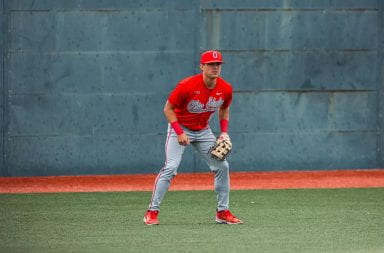
Kyle Dues tending to the Ohio State Mansfield microfarm in its early stages. Credit: Courtesy of Kyle Dues
When Kyle Dues set out to intern for an on-campus microfarm during his first semester of college, neither he nor the local community knew what was coming.
Dues, now a third-year in forestry, fisheries and wildlife, has been instrumental in piloting microfarming in Mansfield, Ohio, with Kip Curtis, associate professor of environmental history. Their agricultural project has since brought food solutions and educational opportunities to the Ohio State Mansfield community.
Microfarming is a small-scale agricultural system that allows farmers to grow crops in a small plot of land in bustling areas that are outside of a 10-mile radius for fresh fruits and vegetables known as food deserts, Dues said.
“The purpose of the microfarm is to solve food desert crisis in small towns, especially in the rust belt region,” Dues said. “What we are trying to do is place the microfarm in those food deserts to combat that so everyone in that community then has access to fresh local foods and vegetables.”
What began as a small project in a parking lot has expanded to seven microfarms in one area, creating more food for students, as well as a place for local farmers to come together and negotiate to sell the crops, Dues said.
The project gained support in January from the Foundation for Food and Agriculture Research with a $1 million grant to stimulate innovation in urban agriculture. With this new grant, the project will add three new microfarms, Curtis said.
“The on-campus microfarm is a model for what is, we believe, going to be an innovative new urban agriculture productive system that is going to be scalable and replicable all over,” Curtis said.
Dues and Curtis hope to bring microfarms to every Ohio State campus and provide the broader Ohio State community with food abundance, internships and educational opportunities that have been provided by their microfarm in Mansfield.
“We would love to have every regional campus and Columbus campus to have their own microfarm as a production site,” Curtis said. “We could roll it out as quickly as next year if someone on a campus is interested.”
Curtis cites Dues’ initiative and dedication as instrumental to the microfarm’s success.
“Kyle was really just critical in encouraging other students and being a peer and peer mentor,” Curtis said. “And that’s why I built the microfarm in the first place, [so] students like Kyle could really shine and really get an opportunity to be engaged in real-world, real-time, innovative research projects.”
Dues hopes to see the project expand to other regions in Ohio and the country.
“It started in empty parking lots,” Dues said. “In my dreams, when I was building this, I never thought this project would get as big as it did.”


